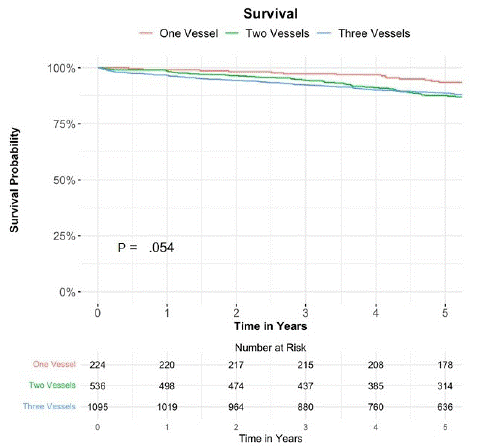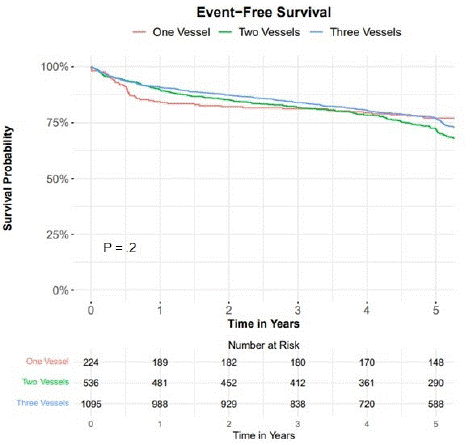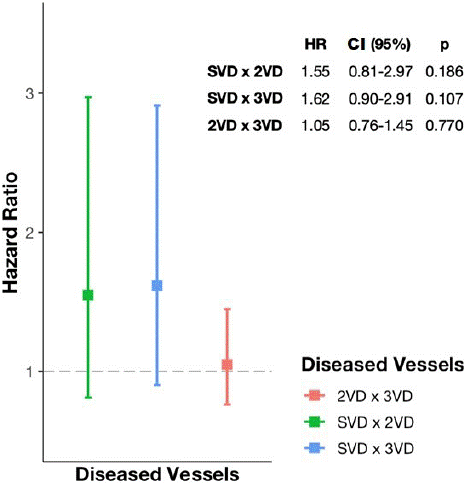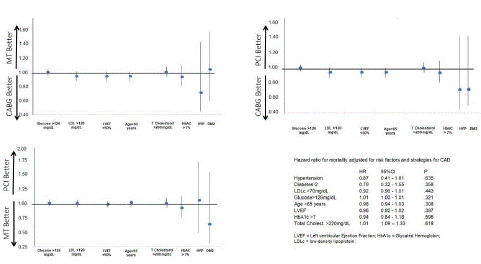
Research Article
J Cardiovasc Disord. 2023; 9(1): 1053.
Mortality Associated with the Number of Diseased Vessels and Therapeutic Strategies for Coronary Artery Disease: Long-Term Follow-Up
Guilherme Fernandes de Carvalho, MD; Whady Hueb, MD*, PhD; Paulo Cury Rezende, MD, PhD; Eduardo Gomes Lima, MD, PhD; Paulo Rogério Soares, MD, PhD; Thiago Luis Scudeler, MD, PhD; Edimar Alcides Bocchi, MD, PhD; José Antônio Franchini Ramires, MD, PhD; Roberto Kalil Filho, MD, PhD
Instituto do Coração (InCor), Hospital das Clínicas HCFMUSP, Faculdade de Medicina, Universidade de São Paulo, SP, Brazil
*Corresponding author: Whady Hueb, Av. DrEneas de Carvalho Aguiar 44, AB, Sala 114, Cerqueira César, São, Paulo-SP/Brazil. Tel: 55 11 2661 5032; Fax: 55 11 2661 5188 Email: whady.hueb@incor.usp.br
Received: October 05, 2023 Accepted:October 28, 2023 Published: November 04, 2023
Abstract
Background: The number of coronary arteries affected by atherosclerosis is believed to impact the prognosis of coronary artery disease, resulting in a higher incidence of cardiac events. However, conclusive results on the relationship between the extent of coronary atherosclerosis and outcomes are lacking.
Methods: This retrospective, single-center, observational cohort study included patients with stable coronary artery disease and preserved ventricular function who had the option of any of the three therapeutic strategies (medicine, angioplasty, or surgery) included in the MASS-Trials database. Patients were stratified according to the number of diseased arteries forming single-vessel, double-vessel, and triple-vessel disease groups. The atherosclerotic burden was assessed using the SYNTAX Score. Each group was eligible for any of the three therapeutic strategies. The primary endpoint was overall mortality. Secondary endpoints included the combination of all-cause death, nonfatal myocardial infarction, and additional coronary interventions.
Results: Between May 1998 and June 2009, 2,000 patients who met the inclusion criteria in the MASS-Trial database were included. The study enrolled 1,855 patients. Of these, 224(12%) had single-vessel disease (SVD), 536(29%) had double-vessel disease (2VD), and 1,095(59%) had triple-vessel disease (3VD). The entire follow-up of our sample was 5 years. Overall mortality for SVD, 2VD, and 3VD was 9(4%), 33(6.3%), and 43(3.9%), respectively (P=0.054). Pairwise comparison of mortality at 5-year follow-up showed no significant differences between SVD x 2VD, SVD x 3VD, and 2VD x 3VD (hazard ratio [HR] 1.41, 95% CI: 0.81-2.44). The secondary endpoints (combination of overall mortality, nonfatal infarction, and additional revascularization) also revealed no significant differences (P=0.2).
Conclusions: Overall mortality was similar regardless of the number of diseased arteries and the degree of arterial involvement. These data suggest that optimized medical treatment as an initial strategy is safe and has a similar rate of events in any applied therapeutic option.
Keywords: Coronary artery disease; Stable angina; Number of diseased vessels; Therapeutic strategies
Introduction
The long-term prognosis of Coronary Artery Disease (CAD) historically attributes to the number of diseased arteries. This concept is derived from the myocardial area at risk and the degree of luminal stenosis [1]. When associated, these two conditions carry substantial weight in the prognosis of coronary disease and may result in higher rates of occurrence of events and premature death. Initial studies on mortality related to the number of diseased vessels identified increased mortality associated with the degree of arterial involvement [2]. Similarly, other studies individualized artery by artery and their respective sites and associated them with their prognosis [3-4]. Moreover, they compared the prognosis of the artery in isolation and association with other arteries. For instance, the effect of associating the anterior Descending Artery (DA) with the Circumflex artery (CX) is different from the association between CX and the Right Coronary artery (RC). Finally, patients with disease in one vessel were compared with those with two-vessel and three-vessel involvement. Refinements regarding the number of affected arteries, the degree of arterial impairment, and the location of luminal stenosis identified a strong relationship with prognosis. Disease severity, interpreted as the occurrence of events, was more strongly associated with proximal lesions than with distal lesions, stenosis severity, and the number of affected vessels [5]. However, these studies did not consider ventricular function as a predictor of prognosis. In fact, studies with the objective of identifying this condition found conflicting mortality results in patients with the same compromised artery but without assessing the degree of ventricular function [6]. Thus, patients with the same number of vessel disease with ventricular dysfunction experienced marked mortality compared to those with preserved ventricular function [7]. Coronary interventions, both percutaneous and surgical, were developed to change this situation. Several studies have shown real benefit, in the long term, of interventions in certain subgroups of patients, changing the prognosis in the short and long term [8]. The present study reports a long-term follow-up of patients enrolled in the database of The Medicine, Angioplasty, or Surgery Study (MASS-Trials) with stable angina, preserved ventricular function stratified by the number of diseased vessels.
Methods
Study Design and Patient Population
Patients with obstructive coronary artery disease with proximal stenosis of more than 70%, confirmed ischemia, and considered equally treatable with the three strategies were enrolled between May 1998 and June 2009 in the MASS Trial database. The MASS registry, which includes details on recruitment, inclusion and exclusion criteria, objectives, data collection, patient management, procedural guidelines, and event definitions, has been previously published [9]. Briefly, the MASS-Registry includes randomized and non-randomized prospective unicentric patients, comparing surgical, percutaneous, or medical therapy strategies in those with stable coronary disease and preserved ventricular function. Patients who were clinically eligible for any therapeutic strategy and who consented to enter the study were prospectively followed up for over 5 years. Myocardial ischemia was documented by a stress test or in the occurrence of angina pectoris assessment of the Canadian Cardiovascular Society (CCS) (Class II or III). Thus, all patients included were approved based on interventional cardiology and the surgeon, who indicated that revascularization could be performed using any strategy. In the present study, patients were grouped according to the number of diseased arteries. So, the study population included patients with Single-Vessel Disease (SVD), patients with Two-Vessel Disease (2VD), and patients with Three-Vessel Disease (3VD). The ethics committee of the Heart Institute approved the protocol, and all procedures were performed following the Declaration of Helsinki. Written informed consent was obtained from every patient.
Treatment Protocol
The medications administered to the patients were similar in the three study groups. All patients received aspirin and/or clopidogrel, and optimal medical therapy, consisting of a stepped-approach using nitrates, beta-blockers, calcium channel blockers, angiotensin-converting enzyme inhibitors, or a combination of these drugs, unless contraindicated, was used to keep the patient free of angina. Statins were also prescribed along with a low-fat, low-carbohydrate diet on an individual basis. Insulin and oral hypoglycemic agents were also used in patients with diabetes. As it was a public hospital, medications were provided free of charge. Finally, patients were assigned to continue aggressive medical therapy alone or to undergo Percutaneous Coronary Intervention (PCI) or Coronary Artery Bypass Graft (CABG) concurrently with Medical Therapy (MT).
For patients referred for PCI, the procedure was available shortly after assignment. Devices used for catheter-based therapeutic strategies, including stents, lasers, directional atherectomy, and balloon angioplasty, were at the discretion of the operator. Angioplasty was performed according to a standard protocol. The interventional cardiologist was encouraged to treat all arteries that were likely to contribute to ischemia and/or had >70% diameter stenosis. Successful revascularization in the PCI group was defined as a residual stenosis of <50% reduction in luminal diameters with grade 3 Myocardial Infarction (TIMI) flow thrombolysis. Patients treated with coronary stents were maintained on clopidogrel 75mg for 12 months, plus lifetime aspirin.
Patients assigned to the CABG group required the operation shortly after assignment. Complete revascularization was accomplished, if technically feasible, with saphenous vein grafts, internal mammary arteries, and other conduits such as radial or gastroepiploic arteries. The use of the left internal mammary artery to graft the left anterior descending coronary artery was strongly advised for all cases.
Equivalent revascularization was encouraged but not mandatory. Standard surgical techniques were used under hypothermic arrest with blood cardioplegia. No off-pump CABG was performed.
Study Endpoints
Patients were evaluated every three months during the first year of inclusion and every six months until the 5th year of follow-up. The primary endpoint was predefined as death from any cause, while the secondary endpoint was defined as a composite of death from any cause, nonfatal myocardial infarction, and angina requiring revascularization. Myocardial Infarction (MI) was defined as the presence of significant new Q-waves in at least two ECG leads or symptoms compatible with MI associated with troponin concentrations that were more than five times the upper limit of the reference range. The primary endpoint of the study aimed to compare the mortality rates of patients with CAD according to the number of diseased vessels, stable angina, and preserved left ventricular function at a five-year follow-up. In addition, we stratified the results based on the number of diseased vessels and the treatment option (surgical, percutaneous, or medical).
Statistical Analysis
Statistical analysis was conducted using the SPSS software. Differences in clinical and demographic baseline characteristics among groups were assessed using chi-square or Fisher's exact test for dichotomous variables and t-tests or Wilcoxon tests for continuous variables. Event rates were estimated using the Kaplan-Meier method, and differences among groups were compared using the log-rank test. The Cox proportional hazards method was utilized to develop a multivariate model of 5-year mortality rates, including variables such as age, hypertension, gender, hyperlipidemia, number of coronary diseases, and treatment allocation. All data were analyzed according to the intention-to-treat principle rather than the treatment received. All tests were two-tailed, and a P-value of <0.05 was considered statistically significant.
Results
Between May 1998 and June 2009, 2,000 patients who met the inclusion criteria were included in the MASS-Trial database. The study consisted of 1,855 patients, of whom 224(12%) had Single-Vessel Disease (SVD), 536 (29%) had double-vessel disease (2VD), and 1,095(59%) had Triple-Vessel Disease (3VD). The follow-up period for the entire sample was 5 years. The cohort flow diagram is presented in Figure 1.

Figure 1: Consort diagram of trial participants.
MT denotes: Medical Therapy; PCI Percutaneous Coronary Intervention and CABS Surgical Revascularization.
In patients with single-vessel disease, a similar distribution was observed for each therapeutic option, i.e., 33% for each one. For those with double-vessel disease, medical and percutaneous treatments had a similar percentage (mean 30%), whereas surgical strategies were the most common option (40%). In patients with triple-vessel disease, 57% received surgical treatment, and medical and percutaneous interventions had similar percentages (22% each). Other demographic, clinical, and laboratory variables were similar and are available in Table 1.
Characteristics
Single (n=224)1
Double (n=536)1
Triple (n=1095)1
P value2
Demographic profile
Age (Years), mean (SD)
58(49±64)
60(53±67)
62(55±68)
<.001
Male, n (%)
158(71)
354(66)
762(70)
.308
Medical history, n (%)
Current smoker
85(38)
216(40)
455(42)
.602
Hypertension
83(37)
359(67)
814(74)
<.001
Diabetes mellitus
49(22)
338(63)
691(63)
<.001
CCS-Class II/III angina
150(71)
235(87)
590(88)
<.001
Laboratory values (mmol/L)
Total cholesterol
5.9(4.9±6.9)
5.5(4.8±6.3)
4.9(4.0±5.8)
<.001
LDL-cholesterol
3.8(3.1±4.5)
3.3(2.5±4.0)
3.1(2.4±4.0)
<.001
HDL-cholesterol
1.0(0.9±1.1)
1.0(0.8±1.1)
1.0(0.8±1.1)
.019
Triglycerides
2.0(1.4±2.0)
1.7(1.3±2.5)
1.8(1.3±2.5)
.042
SYNTAX-Score
7.0(0±0)
16(12±21)
.017
Ejection Fraction
60(59±69)
65(59±70)
65(60±70)
.600
Strategies, n (%)
Surgical
71(32)
217(40)
625(57)
Percutaneous
77(34)
145(27)
228(21)
<.001
Medical treatment
76(34)
174 (32)
242 (22)
Medications, n (%)
Beta-blockers
216(96)
511(95)
1018(92)
.32
Calcium-channel blockers
198(88)
485(90)
1011(92)
.74
Nitrates
201(89)
518(96)
1025(93)
.66
Aspirin- Clopidogrel
209(93)
522(97)
1060(96)
.46
Diuretics
22(9)
72(13)
125(11)
.71
Hypoglycemics agents
62(27)
142(26)
308(28)
.21
ACE-inhibitor
181(80)
445(86)
1003(91)
.40
ARB
42(18)
325(60)
512(46)
.44
Statins
210(93)
511(95)
1080(98)
.84
Ezetimibe/ others
26(11)
59(11)
105(9.5)
.38
Positive Treadmill Test, n (%)
156(75)
207(79)
575(79)
.81
1 Median (IQR); n (%); 2 Kruskal-Willi’s rank sum tests; Pearson's chi-squared test; CCS-Class, Canadian Cardiovascular Society grading of angina pectoris. ACE-Inhibitors, Angiotensin-converting Enzyme; ARB; Angiotensin Receptors Blockers
Table 1: Baseline characteristics of 1,855 patients with single-, double-, and triple-vessel disease.
Substantial data from baseline characteristics were similar. Notably, triple-vessel disease patients were observed to be older compared to single-vessel disease patients (P<.001). Laboratory data with significant differences were considered spurious. No differences were observed in the distribution of strategies among groups based on the number of vessel disease.
Angiographic characteristics were similar between the groups (Table 2). The data on the rate of revascularization in each corresponding territory (anterior, lateral, and inferior wall) were similar among the studied groups. This index also followed percutaneous treatment. Relevant data were observed in the circumflex and right coronary artery territory in 2VD patients compared to 3VD patients. This was repeated in the percutaneous treatment. For patients who received percutaneous treatment, close to 90% received stents, whereas for the surgical group, close to 95% received a graft with an Internal Mammary Artery (LIMA).
SVD
(n=224)2VD
(n=536)3VD
(n=1.095)
Mean Ejection Fractions LV
60(59±69)
65(59±70)
65(60±70)
Proximal LAD =95%
92
89
91
Media-Distal LAD
8
11
9
Vessel Territory
LAD
100
92
89
LCX
0
89
91
RCA
0
91
90
SVD: Single Vessel Disease; 2VD: Double Vessel Disease; 3VD: Triple Vessel Disease; LV: Left Ventricle; LAD: Left Descending Artery; LCX: Left Circumflex Artery; RCA: Right Coronary Artery.
Table 2: Angiographic characteristics of patients by number.
Percutaneous coronary intervention was successfully performed in 96% of patients with single-vessel disease, 92% of those with double-vessel disease, and 90% of those with triple-vessel disease.
All patients with single-vessel disease received LIMA, while 96% and 92% of patients with double-vessel and triple-vessel disease, respectively, received LIMA, with a mean of 3.5±0.9 vessels bypassed.
At least 92% of patients received LIMA, and 42% received both radial artery and Right Internal Mammary Artery (RIMA). The epigastric artery was used as a graft in 14% of patients.
Clinical Outcomes
Table 3 shows similar rates of mortality, myocardial infarction, and combined events among the three study groups during the five-year follow-up.
SVD (n=224)1
2VD (n=536)1
3VD (n=1095)1
P value2
Overall mortality (%)
9(4)
33(6.3)
43(3.9)
.054
Myocardial infarction (%)
6(2.6)
21(3.9)
41(3.7)
.277
Additional revascularization (%)
13(5.8)
25(4.7)
40(3.7)
.019
Combined events (%)
19(8.5)
59(11)
98(8.9)
.20
n (%)1; log-rank2; SVD, single-vessel disease; 2VD, double-vessel disease; 3VD, triple-vessel disease.
Table 3: Mortality and outcomes during follow-up.
The rate of additional revascularization was significantly higher in patients who underwent repeat angioplasty.
The Kaplan-Meier curve (Figure 2) demonstrates a similar mortality rate among the groups with single-, double-, and triple-vessel disease (P=.054 by log-rank). The cumulative survival rates were 93.75%, 89.55%, and 89.05% for patients with one, two, and three-vessel disease, respectively.

Figure 2: Probability of survival free of overall mortality among patients with single-, double-, and triple-vessel disease.
The Kaplan-Meier analysis for the occurrence of combined events did not reveal any statistical differences between the groups (Figure 3).

Figure 3: Probability of combined event-free survival among patients with one-, two-, and three-vessel disease.
Figure 4 shows that there was no significant interaction (P<.01) between the effect of the treatment strategies and any predefined subgroup variable. It is worth noting that there was a significant difference (P<.001) between patients with multivessel coronary artery disease, diabetes, and hypertension.

Figure 4: Hazard ratio for mortality comparing between groups: CABG vs MT; CABG vs PCI; MT vs PCI. Obtained from Cox Regression Model to evaluate relative survival differences.
When these subgroup variables were included in a multivariate analysis, the hazard ratio for death from the applied treatments remained essentially unchanged (Hazard Ratio [HR] 1.41, 95% CI: 0.81-2.44).
The pairwise treatment comparison of mortality at 5-year follow-up revealed no significant differences between patients with single-vessel disease versus those with double-vessel disease, single-vessel disease versus those with triple-vessel disease, or double-vessel disease versus those with triple-vessel disease (HR 1.41, 95% CI: 0.81-2.44) (Figure 5).

Figure 5: Pairwise treatment comparison of mortality between strategies.
Discussion
Analysis of the data from the present study revealed that, regardless of the number of affected vessels, the degree of arterial involvement, patients with stable angina and preserved ventricular function, patients experienced similar life expectancy after optimized medical treatment and both percutaneous and surgical coronary intervention. In fact, the survival rate in five years of follow-up, in this studied sample, was 93.37%, 89.55%, and 89.95% (p=.054) for patients with single-, double-, and triple-vessel disease, respectively. Additionally, when we evaluated the combined occurrence of death, acute myocardial infarction, and unplanned surgery, at the same follow-up time, no differences were observed between groups (P=.2). Considering that patients in the three therapeutic groups received optimized drug therapy, interventions, both percutaneous and surgical, compared with medical treatment, did not achieve a reduction in death, myocardial infarction, or unplanned intervention, even though there was a high prevalence of coexisting clinical diseases. Although the degree of relief from angina pectoris and better exercise tolerance assessed by the stress test was observed predominantly in patients who received percutaneous or surgical intervention, this did not reflect on the protection of the occurrence of events. Compared to the medical group, angina rates were lower in the percutaneous and surgical groups, especially in the first year of follow-up. However, in subsequent years there was equalization between the groups. Whether these data are related to the good performance of the optimized medical treatment should be investigated in the future. All secondary endpoints and individual components of the primary endpoint were not significantly different between study groups. This was observed both in single-vessel disease patients undergoing the three therapeutic strategies and in patients with double- or triple-vessel disease. Furthermore, there was no significant interaction between treatment effects and any subgroup variable. Our data can be explained, on the one hand, by the stability of symptoms and strict clinical control based on optimized medical therapy for all groups and on the other hand due to the presence of preserved left ventricular function in all patients. Additionally, assuming that patients with single vessel disease have a lower atherosclerotic burden and therefore a lower likelihood of repetitive events occurring, this advantage did not translate into a better prognosis due to the absence of repetitive ischemic events recorded in patients with multivessel disease. This reinforces the idea that repetitive coronary events over time are not a common occurrence. These data suggest that patients with multivessel disease may have experienced events only in one unstable plaque while other diseased lesions remained stable during the follow-up period. In this context, a recent study evaluating atherosclerotic burden using the SYNTAX Score did not find any difference in mortality regardless of the score or strategy applied [11]. It should be noted that the reduction in overall mortality as the primary endpoint in this study, and in most randomized trials, does not necessarily reflect the assessment of treatment strategies. In fact, the mortality analysis of the ISCHEMIA Trial revealed that nearly 50% of deaths were from non-cardiac causes, with an overall mortality of 12.7% for the intervention arm compared to 13.4% for conservative therapy (P=.74), while cardiovascular mortality was only 6.4% for the invasive group and 8.6% for the conservative group (P=.008) [11]. Finally, this study, based on patients with stable angina, preserved ventricular function, and optimized medical treatment, suggests that percutaneous or surgical coronary intervention was not able to decrease the rate of occurrence of cardiovascular events or other causes.
Final Considerations
The data from this study align with current clinical practice guidelines that recommend safely postponing both percutaneous and surgical revascularization in patients with stable coronary disease, regardless of the number of diseased arteries and the degree of arterial involvement. Exceptions are made for patients with left main coronary disease and ischemic ventricular dysfunction. However, these patients may develop instability of the atheromatous plaque followed by angina pectoris during long-term follow-up and may be candidates for both percutaneous and surgical intervention.
In summary, our study compared the three available therapeutic strategies for stable chronic coronary disease with preserved left ventricular function and evaluated whether the atherosclerotic burden, understood as the degree of arterial involvement, had any impact on the disease's prognosis. The main finding of this study was the similarity in the occurrence of death from all causes, regardless of the number of affected arteries. Therefore, we can consider optimized medical treatment as a safe initial strategy with a similar rate of events in any applied therapeutic option.
Study Limitations
Our study has some limitations. Firstly, it was conducted at a single center and with a relatively small sample size, which reduces its external validity. However, this also results in a more homogeneous sample and therapeutic decisions that adhere to the same guidelines. Furthermore, some prespecified subgroups had a very low prevalence, and the statistical power was insufficient to detect interactions between treatment and subgroup. Additionally, the significant variability of clinical presentations and associated morbidities is a reflection of real-world practice and can be considered strength rather than a weakness of the study.
Author Statements
Acknowledgments
Support for the present study was provided in part by the Zerbini Foundation, São Paulo, Brazil, and Ann Conti Morcos of Morcos Media provided medical writing support during the preparation of this paper. The authors are solely responsible for the design and conduct of this study, all study analyses, the drafting and editing of the paper, and its final contents.
Funding
Financial support for the present study was provided in part by a research grant from the Zerbini Foundation.
References
- Califf RM, Armstrong PW, Carver JR, D’Agostino R, E Strauss W. Task Force 5: stratification of patients into high-, medium-, and low-risk subgroups for purposes of risk factor management. J Am Coll Cardiol 27th Bethesda, M.D Conference: matching the intensity of risk factor management with the hazard for coronary disease events. 1996; 27: 964-76.
- Webster JS, Moberg C, Rincon G. Natural history of severe proximal coronary artery disease as documented by coronary cineangiography. Am J Cardiol. 1974; 33: 195-200.
- Zack PM, Chaitman BR, Davis KB, Kaiser GC, Wiens RD, Ng G. Survival patterns in clinical and angiographic subsets of medically treated patients with combined proximal left anterior descending and proximal left circumflex coronary artery disease (Cass). Am Heart J. 1989; 118: 220-7.
- Chaitman BR, Davis K, Fisher LD, Bourassa MG, Mock MB, Lespérance J, et al. A life table and Cox regression analysis of patients with combined proximal left anterior descending and proximal left circumflex coronary artery disease: non-left main equivalent lesions (Cass). Circulation. 1983; 68: 1163-70.
- Mark DB, Nelson CL, Califf RM, Harrell FE, Lee KL, Jones RH, et al. Continuing evolution of therapy for coronary artery disease. Initial results from the era of coronary angioplasty. Circulation. 1994; 89: 2015-25.
- Alderman EL, Fisher LD, Litwin P, Kaiser GC, Myers WO, Maynard C, et al. Results of coronary artery surgery in patients with poor left ventricular function (Cass). Circulation. 1983; 68: 785-95.
- CASS Principal Investigators and their Associates: Coronary Artery Surgery Study (CASS): a randomized trial of coronary artery by-pass surgery. Survival data. Circulation. 1983; 5: 939-50.
- Caracciolo EA, Davis KB, Sopko G, Kaiser GC, Corley SD, Schaff H, et al. Comparison of surgical and medical group survival in patients with left main equivalent coronary artery disease. Long-term CASS experience. Circulation. 1995; 91: 2335-44.
- The MASS Investigators. The medicine, angioplasty, surgery study (MASS). ISRCTN66068876 https://doi.org/10.1186/ISRCTN66068876.
- Scudeler TL, Farkouh ME, Hueb W, Rezende PC, Campolina AG, Martins EB, et al. Coronary atherosclerotic burden assessed by SYNTAX scores and outcomes in surgical, percutaneous or medical strategies: a retrospective cohort study. BMJ Open. 2022; 12: e062378.
- Hochman JS, Anthopolos R, Reynolds HR, Bangalore S, Xu Y, O’Brien SM, et al. Survival After Invasive or Conservative Management of Stable Coronary Disease. Circulation. 2023; 147: 8-19.